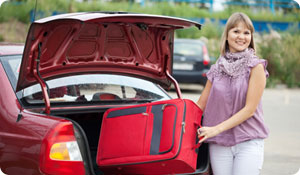
Whether traveling on business, vacationing with the family or friends, looking your best will likely be on your itinerary. But packing your favorite skin and hair care products can be complicated. Thanks to security threats courtesy of Al Qaeda and other terrorist groups, the Transportation Security Administration (TSA)-as well as individual airlines-has imposed restrictions aimed at keeping travelers safe.
Not complying with the rules can cost you valuable time and unnecessary hassle at the airport. Before you zip up your suitcase, review these tips from the TSA and the Federal Aviation Administration (FAA) and to arrive in style and on time.
To Pack or Not to Pack? Learn the 3-1-1 Rule
After an alleged plot to sabotage U.S. airlines with liquid and gel-based explosives was uncovered by authorities in the United Kingdom in August 2006, restrictions to these items were put into place. Since so many personal grooming products (hair and skin care items, toothpaste, mouthwash, etc) come in liquid and gel form, the TSA developed the 3-1-1 rule to help passengers comply with the new regulations:
3.4 ounces (100 ml) is the allowable container size for all liquids, gels and aerosols. Larger containers that are half-full or toothpaste tubes rolled up are not allowed in carry-on luggage.
1 quart-size, zip-top clear plastic bag (plastic gallon-size bags or the fold-over sandwich variety are not permitted) is allowed to fit all 3.4 ounce items comfortably in your carry-on.
1 quart-sized, zip-top bag has to be removed from your carry-on and placed in a bin or on the conveyor belt for separate X-ray screening. This enables TSA security officers to more-easily examine these items.
Aerosols like hairspray and deodorant; hair gel and shaving cream are allowed in the airplane's cabin but can't be brought on board in containers larger than 3.4 ounces.
Many stores today have areas devoted to travel-sized toiletries. Here's more information (and photos) about the TSA's new regulations.
Other permissible grooming items include:
- Metal nail clippers with nail files attached
- Tweezers
- Disposable razors
- Deodorant
Medically necessary liquids such as contact lens solution are exceptions to the 3-1-1 rule. "If you need to have your contact lens solution with you during the flight, remove it from your carry-on bag and display it to a transportation security officer prior to the bag going through the X-ray machine," advises Jonathan Allen, spokesperson for the Department of Homeland Security. "The regular-size bottle will likely undergo an additional screening that should take less than two minutes."
Keep in mind, once you've passed through security screening, you can purchase any size beverage and other liquid or gel products in the terminal and bring them onto the plane.
What's the Hold Up?
The secret to getting through security smoothly is to de-clutter your carry-on bag. The FAA suggests packing in an organized manner using layers. Start with a layer of clothes, then electronics, more clothes, and then any heavier items. This lets TSA officers get a clear, uncomplicated X-ray image of your carry-on.
According to Allen, "Passengers can save time by being prepared for the process. Besides removing shoes and following the 3-1-1- rule, another good tip is to put items such as keys, cell phone, jewelry, spare change etc. in a purse, laptop bag, or carry-on bag as opposed to placing them loosely into a bin."
If a passenger inadvertently puts a non-restricted liquid item (for example, a bottle of shampoo that is larger than 3.4 ounces) in his carry-on bag, the item will not be confiscated but it won't be allowed on the plane either.
"If the prohibited item-such as an oversize liquid-is discovered, the passenger has the option to leave the checkpoint and take it back to his car, give it to a friend who is still at the airport, or mail it home," Allen explains. "If the item is of limited value (like a bottle of water) many passengers simply elect to surrender it."
Wrapped gifts can also slow the process down. If you are bringing a gift to your destination don't wrap it until you arrive. Security officers won't hesitate to unwrap gifts that need to be inspected.
Securing the Contents
If you lock your luggage, use a universal "master" key lock. Security officers are less likely to cut it and these kinds of locks are available at airports and travel stores nationwide. Or, search online for TSA-approved luggage locks.
Following the rules will help ensure that you look great and make your flight. Happy trails!
Sources:
Interview (via email), Jonathan Allen at the Department of Homeland Security (DHS)
The Transportation Security Administration
http://www.tsa.org
Frequently-Asked Questions
http://www.Faqs.org
Federal Aviation Administration
http://www.faa.gov





